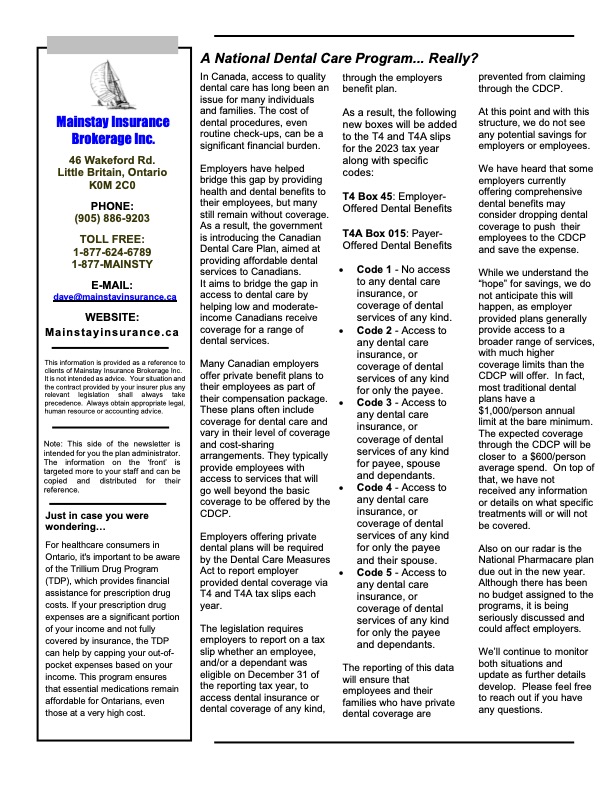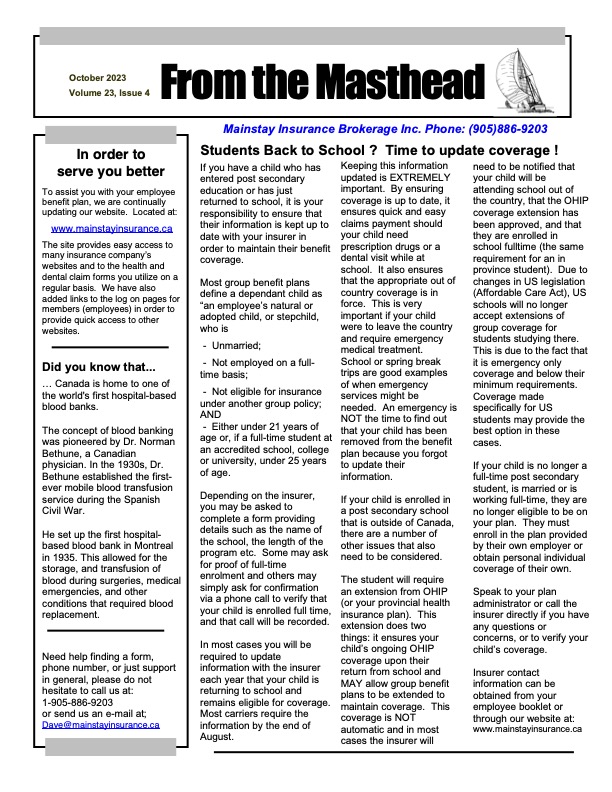The new National Dental Plan is coming into force in 2024. As such, employers are required to share if they have benefits coverage, and how staff and their families are covered. We posted this past month, but are reposting with updates…
The program provides coverage for kids under the age of 18, people with disabilities and seniors. Initially, this will program will benefit families with net annual incomes below $90,000 and NO private coverage of any kind.
Most employers will not make changes to their offering, as private plans are likely to provide far superior coverage to the federal plan. That said, clients that have dental plans (OF ANY KIND) will need to report the fact on T-4’s each year.
As I have been fielding questions from advisors across Canada (through CGIB), I’ve come across many of the same questions. I thought posting them here may answer some of the questions you may have.
- What about employees that “waive” coverage? How are they coded? (3, 4, or 5)
- What if an employee lost coverage/job? (An amended T4? – We aren’t sure just yet.)
- What about classes that have no benefit? (Code1)
- What about growing families (Where staff are moving from “single” to “family coverage)? (Code 3)
- What about 2024 mid year hires? (Code on 2024 T4’s)
- What about Health Spending Accounts (HSA’s)? Do they need to be reported? (YES, they can be used to pay dental expenses)
- What if the employee used up the HSA for health? (Code 2 or 3, same as someone who used up an insured dental benefit)
- Can an HSA be structured to EXCLUDE dental coverage from eligible expenses? (Yes, with some providers. if that is chosen then Code 1)
- Why don’t we just drop dental coverage to let the government plan cover it? (it’s limited coverage and has $90K household income cut-off)
This article from the payroll Company “Knit People” provides a good summary.
To support the implementation of the Canadian Dental Care Plan (CDCP), the 2023 Budget Implementation Act includes legislative updates to permit its effective administration of the Dental Care Measures Act.
The Dental Care Measures Act will permit the collection of Social Insurance Numbers from applicants and require the reporting of employer-provided dental coverage via T4 and T4A tax slips.
The legislation requires employers to report on a tax slip whether an employee, former employee, or a spouse of a deceased employee was eligible on December 31 of the reporting tax year, to access dental insurance or dental coverage of any kind, due to current or former employment.
This includes access to ongoing (not one-time occurrence/exceptional) dental care coverage, reimbursement, or insurance as an employee or retiree benefit. Whether or not an individual made use of, or accepted coverage/insurance is not reported. Reporting covers only whether or not it was available to them.
Employers may include Pension Plan Administrators and other organizations that complete T4As and T4s annually.
This reporting requirement will be mandatory beginning with the 2023 tax year reporting cycle, and will continue to be required on an annual basis.As a result, the following new boxes will be added to the T4 and T4A slips for the 2023 tax year along with specific codes:
T4 Box 45: Employer-Offered Dental Benefits
T4A Box 015: Payer-Offered Dental Benefits
Code 1 – No access to any dental care insurance, or coverage of dental services of any kind.
Code 2 – Access to any dental care insurance, or coverage of dental services of any kind for only the payee.
Code 3 – Access to any dental care insurance, or coverage of dental services of any kind for payee, spouse and dependants.
Code 4 – Access to any dental care insurance, or coverage of dental services of any kind for only the payee and their spouse.
Code 5 – Access to any dental care insurance, or coverage of dental services of any kind for only the payee and dependants.


